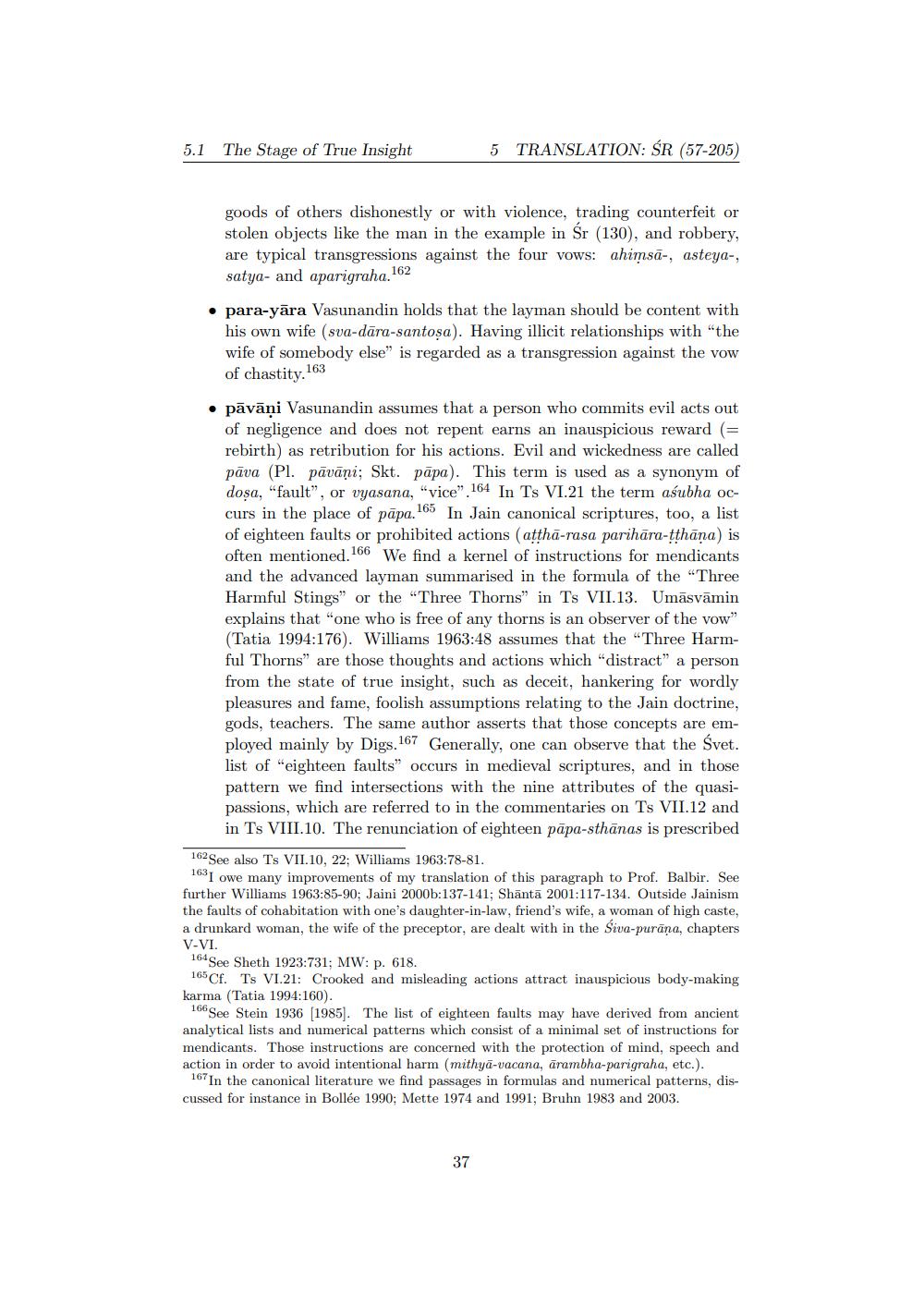________________
5.1
The Stage of True Insight
5 TRANSLATION: ŚR (57-205)
goods of others dishonestly or with violence, trading counterfeit or stolen objects like the man in the example in Sr (130), and robbery, are typical transgressions against the four vows: ahimsa-, asteya-, satya- and aparigraha.162
• para-yāra Vasunandin holds that the layman should be content with his own wife (sva-dāra-santosa). Having illicit relationships with "the wife of somebody else" is regarded as a transgression against the vow of chastity. 163
• pāvāni Vasunandin assumes that a person who commits evil acts out of negligence and does not repent earns an inauspicious reward (= rebirth) as retribution for his actions. Evil and wickedness are called pāva (Pl. pāvāņi; Skt. pāpa). This term is used as a synonym of dosa, "fault", or vyasana, “vice” 164 In Ts VI.21 the term aśubha occurs in the place of pāpa.165 In Jain canonical scriptures, too, a list of eighteen faults or prohibited actions (atthā-rasa parihāra-tthāna) is often mentioned.166 We find a kernel of instructions for mendicants and the advanced layman summarised in the formula of the "Three Harmful Stings" or the "Three Thorns" in Ts VII.13. Umāsvāmin explains that "one who is free of any thorns is an observer of the vow" (Tatia 1994:176). Williams 1963:48 assumes that the "Three Harmful Thorns" are those thoughts and actions which "distract" a person from the state of true insight, such as deceit, hankering for wordly pleasures and fame, foolish assumptions relating to the Jain doctrine, gods, teachers. The same author asserts that those concepts are employed mainly by Digs. 167 Generally, one can observe that the Svet. list of "eighteen faults” occurs in medieval scriptures, and in those pattern we find intersections with the nine attributes of the quasipassions, which are referred to in the commentaries on Ts VII.12 and in Ts VIII.10. The renunciation of eighteen pāpa-sthānas is prescribed
162 See also TS VII. 10, 22: Williams 1963:78-81.
1631 owe many improvements of my translation of this paragraph to Prof. Balbir. See further Williams 1963:85-90; Jaini 2000b:137-141; Shāntā 2001:117-134. Outside Jainism the faults of cohabitation with one's daughter-in-law, friend's wife, a woman of high caste, a drunkard woman, the wife of the preceptor, are dealt with in the Siva-purana, chapters V-VI. 164 See Sheth 1923:731; MW: p. 618. 165 Cf. Ts VI.21: Crooked and misleading actions attract inauspicious body-making karma (Tatia 1994:160).
16 See Stein 1936 (1985). The list of eighteen faults may have derived from ancient analytical lists and numerical patterns which consist of a minimal set of instructions for mendicants. Those instructions are concerned with the protection of mind, speech and action in order to avoid intentional harm (mithya-vacana, ārambha-parigraha, etc.).
167 In the canonical literature we find passages in formulas and numerical patterns, discussed for instance in Bollée 1990; Mette 1974 and 1991; Bruhn 1983 and 2003.




